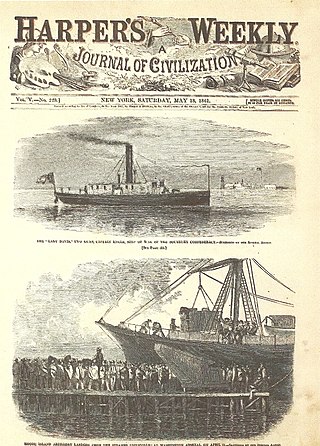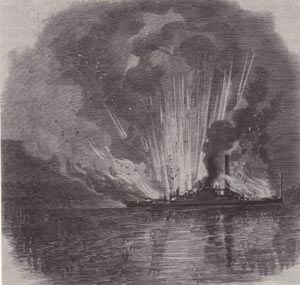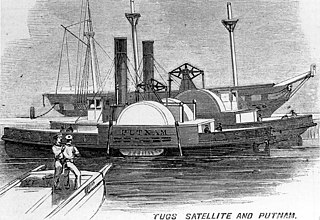
CSS Albemarle was a steam-powered casemate ironclad ram of the Confederate Navy, named for an estuary in North Carolina which was named for General George Monck, the first Duke of Albemarle and one of the original Carolina Lords Proprietor.

USS Southfield was a double-ended, sidewheel steam gunboat of the Union Navy during the American Civil War. She was sunk in action against the Confederate ironclad ram CSS Albemarle during the Battle of Plymouth (1864).

CSSEllis was a gunboat in the Confederate States Navy and the United States Navy during the American Civil War. It was lost during a raid while under command of famed Navy officer Lieutenant William B. Cushing.
The CSS Beaufort was an iron-hull gunboat that served in North Carolina and Virginia during the Civil War.

The Battle of Hatteras Inlet Batteries was the first combined operation of the Union Army and Navy in the American Civil War, resulting in Union domination of the strategically important North Carolina Sounds.

The opening phase of what came to be called the Burnside Expedition, the Battle of Roanoke Island was an amphibious operation of the American Civil War, fought on February 7–8, 1862, in the North Carolina Sounds a short distance south of the Virginia border. The attacking force consisted of a flotilla of gunboats of the Union Navy drawn from the North Atlantic Blockading Squadron, commanded by Flag Officer Louis M. Goldsborough, a separate group of gunboats under Union Army control, and an army division led by Brig. Gen. Ambrose Burnside. The defenders were a group of gunboats from the Confederate States Navy, termed the Mosquito Fleet, under Capt. William F. Lynch, and about 2,000 Confederate soldiers commanded locally by Brig. Gen. Henry A. Wise. The defense was augmented by four forts facing on the water approaches to Roanoke Island, and two outlying batteries. At the time of the battle, Wise was hospitalized, so leadership fell to his second in command, Col. Henry M. Shaw.

CSSLady Davis was a gunboat in the Confederate States Navy during the American Civil War.

USSWhitehead, a screw steamer built in 1861 at New Brunswick, New Jersey, served as a gunboat in the United States Navy during the American Civil War.

The Battle of Elizabeth City of the American Civil War was fought in the immediate aftermath of the Battle of Roanoke Island. It took place on 10 February 1862, on the Pasquotank River near Elizabeth City, North Carolina. The participants were vessels of the U.S. Navy's North Atlantic Blockading Squadron, opposed by vessels of the Confederate Navy's Mosquito Fleet; the latter were supported by a shore-based battery of four guns at Cobb's Point, near the southeastern border of the town. The battle was a part of the campaign in North Carolina that was led by Major General Ambrose E. Burnside and known as the Burnside Expedition. The result was a Union victory, with Elizabeth City and its nearby waters in their possession, and the Confederate fleet captured, sunk, or dispersed.

CSS Curlew was an iron-hull North Carolina Sounds paddlewheel steamboat that was taken into the Confederate Navy in 1861. It was run aground at Fort Forrest and burned in the battle for Roanoke Island on February 8, 1862. Its wreck was discovered in 1988 and archaeologically investigated in 1994.

Black Warrior is the name of a Confederate two-masted schooner that participated in the defense of Roanoke Island in North Carolina during the Civil War. Its brief wartime career ended with its burning at Elizabeth City, North Carolina.

USS General Putnam – also known as the USS William G. Putnam – was acquired by the Union Navy during the first year of the American Civil War and outfitted as a gunboat and assigned to the Union blockade of the Confederate States of America. She also served as a tugboat and as a ship's tender when so required.
USS Shawsheen was a steam operated tugboat acquired by the Union Navy during the American Civil War.

USS Morse was a ferryboat acquired by the Union Navy during the American Civil War.

USS Hetzel was a steamer acquired by the Union Navy during the American Civil War. She was used by the Navy to patrol navigable waterways of the Confederacy to prevent the South from trading with other countries.
USS Isaac N. Seymour, also referred to variously as Seymour, I. N. Seymour and J. N. Seymour, was a steamer acquired by the Union Navy for use as a gunboat during the American Civil War. She was used by the Navy as a littoral ship in fire support, supply and blockading roles.
USS Corwin was a steamer acquired by the Union Navy during the American Civil War. She was used by the Union Navy to patrol navigable waterways of the Confederacy to prevent the South from trading with other countries.
CSS Forrest was a wooden-hulled Confederate gunboat that saw action in the North Carolina sounds in 1861 to 1862. Despite being considered "worn out", she saw continuous service until destroyed after the battle of Elizabeth City in February 1862.

Sylvanus Sawyer was a United States inventor.

CSS Junaluska, also known as Younalaska, was a screw steamer tugboat that saw service with the Confederate States Navy during the American Civil War. Built in Philadelphia, Pennsylvania, in 1860, she was purchased by the Confederates at Norfolk, Virginia, in 1861. Serving off of the coasts of Virginia and North Carolina, she participated in the capture of the gunboat USS Fanny on October 1, 1861, and later in a raid on a Union campsite. She continued to serve along the North Carolina coast until August 1862, when she was sold and broken up.

















